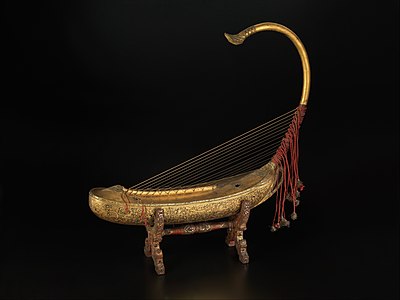From today's featured article
Wiley Rutledge (1894–1949) served as an associate justice of the U.S. Supreme Court from 1943 to 1949. The ninth and final justice appointed by President Franklin D. Roosevelt, he is known for his impassioned defenses of civil liberties. He practiced law in Colorado before becoming a law school professor and dean. Rutledge supported New Deal policies and other proposals by Roosevelt, who appointed him to the D.C. Circuit Court of Appeals in 1939 and to the Supreme Court in 1943. Rutledge favored broad interpretations of the First Amendment, and he argued that the Bill of Rights applied in its totality to the states. In other cases, Rutledge fervently supported broad due process rights in criminal cases, and he opposed discrimination against women and racial minorities. However, he joined the majority in two cases – Hirabayashi v. United States (1943) and Korematsu v. United States (1944) – that upheld the internment of Japanese Americans during World War II. (Full article...)
Did you know ...
- ... that Still Life: An Allegory of the Vanities of Human Life (pictured) includes a skull with missing teeth as a reminder of human mortality?
- ... that clothing physiology is the study of how clothing interacts with the human body and the environment?
- ... that Esmond Venner Keogh was awarded the Distinguished Conduct Medal in World War I and later protested against the Vietnam War?
- ... that Meghan Trainor announced her song "Mother" while 21 weeks pregnant?
- ... that Frank Gadsby, nicknamed "Peggy", was a one-legged British stunt diver during the early 20th century?
- ... that in a lawsuit over Mike Tyson's face tattoo, a judge found it "just silly" to say that tattoos cannot be copyrighted, but refused to delay The Hangover Part II?
- ... that when the 18-year-old New York City Ballet dancer Mira Nadon performed her first major role, The New York Times called her performance a promise to the future?
- ... that people sometimes wonder whether the contortionist Sofie Dossi has a spine?
In the news
- The International Criminal Court issues arrest warrants for Russian president Vladimir Putin (pictured) and Russian official Maria Lvova-Belova for the abduction of children from Ukraine.
- At the Academy Awards, Everything Everywhere All at Once wins seven awards, including Best Picture.
- Iran and Saudi Arabia agree to re-establish diplomatic relations, seven years after they were severed.
- Silicon Valley Bank and Signature Bank both collapse over the span of three days, becoming the second- and third-largest bank failures in U.S. history.
On this day
March 18: Feast day of Saint Cyril of Jerusalem (Christianity)
- 1892 – Canadian governor general Lord Stanley of Preston pledged to donate an award to Canada's top-ranked amateur ice hockey club, now known as the Stanley Cup, the oldest professional sports trophy in North America.
- 1921 – Russian Civil War: Bolshevik forces suppressed a rebellion of sailors and civilians in Kronstadt.
- 1965 – Cosmonaut Alexei Leonov ventured outside the Soviet spacecraft Voskhod 2, becoming the first person to walk in space.
- 1985 – The first episode of the soap opera Neighbours was broadcast on the Seven Network, later becoming the longest-running drama in Australian television history.
- 1990 – Unidentified thieves stole thirteen works of art collectively valued at $500 million from the Isabella Stewart Gardner Museum (pictured) in Boston, Massachusetts.
- Matthew III Csák (d. 1321)
- Charlotte Elliott (b. 1789)
- F. W. de Klerk (b. 1936)
Today's featured picture

|
The saung, also known as the saung-gauk or the Burmese harp, is an arched harp used in traditional Burmese music. It is regarded as the national musical instrument of Myanmar. It was possibly introduced as early as 500 AD from southeastern India, based on archaeological evidence of Burmese temple reliefs that depict a long-necked harp similar to depictions found in Bengal. The earliest evidence of the saung itself is at the Bawbawgyi Pagoda near present-day Prome. At that site, there is a mid-600s sculptured relief depicting the arched harp with about five strings, appearing with musicians and a dancer. It has survived continuously since that time, and has been mentioned in many texts, pictorial representations and Bagan temples. Burmese chronicles describe harps in ceremonial ensembles at medieval Pagan, and female harpists who performed for royals. This 19th-century saung is in the collection of the Metropolitan Museum of Art in New York City. Photograph credit: Metropolitan Museum of Art
Recently featured:
|
Other areas of Wikipedia
- Community portal – The central hub for editors, with resources, links, tasks, and announcements.
- Village pump – Forum for discussions about Wikipedia itself, including policies and technical issues.
- Site news – Sources of news about Wikipedia and the broader Wikimedia movement.
- Teahouse – Ask basic questions about using or editing Wikipedia.
- Help desk – Ask questions about using or editing Wikipedia.
- Reference desk – Ask research questions about encyclopedic topics.
- Content portals – A unique way to navigate the encyclopedia.
Wikipedia's sister projects
Wikipedia is written by volunteer editors and hosted by the Wikimedia Foundation, a non-profit organization that also hosts a range of other volunteer projects:
-
Commons
Free media repository -
MediaWiki
Wiki software development -
Meta-Wiki
Wikimedia project coordination -
Wikibooks
Free textbooks and manuals -
Wikidata
Free knowledge base -
Wikinews
Free-content news -
Wikiquote
Collection of quotations -
Wikisource
Free-content library -
Wikispecies
Directory of species -
Wikiversity
Free learning tools -
Wikivoyage
Free travel guide -
Wiktionary
Dictionary and thesaurus
Wikipedia languages
This Wikipedia is written in English. Many other Wikipedias are available; some of the largest are listed below.
-
1,000,000+ articles
-
250,000+ articles
-
50,000+ articles



